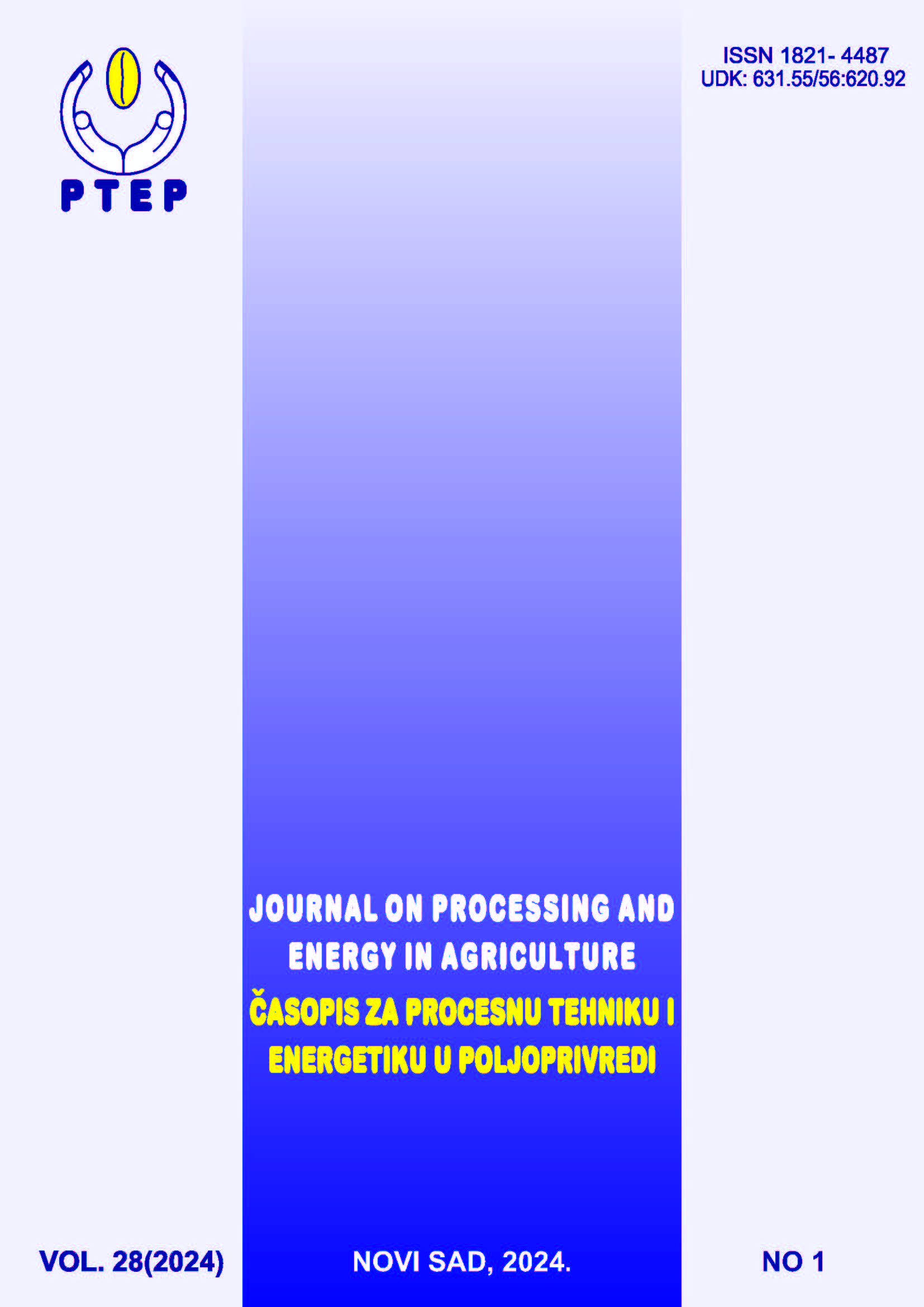LIGNIN REMOVAL FROM CORNCOB BY MICROWAVE-COUPLED PEROXIDE TREAT-MENT
Abstract
Lignocellulosic biomass comprises the crop residues, which remain in large quantities from various stages of crop processing. Its main constituents, cellulose, hemicellulose, and lignin, are interlinked by hydrogen and covalent bonds and form a robust and intricate matrix making it resistant to enzymatic degradation. Pretreatment is crucial in lignocellulosic biomass processing, aiming to remove lignin and enhance enzyme access to polysaccharides.
This study examines how microwave-assisted peroxide pretreatment affects the delignification of corncobs, aiming to enhance the efficiency of utilizing this agricultural residue in fermentation processes. Taguchi orthogonal array was used to optimize pretreatment conditions and assess the effects of individual parameters (temperature, H2O2 dose, and pretreatment time) on delignification efficiency.
The results showed the significant influence of pretreatment conditions on lignin removal from corncobs, with the highest delignification achieved at an H2O2 dose of 500 mg/g, temperature of 100 °C, and pretreatment time of 2 minutes. H2O2 dose had the most substantial impact on the delignification, followed by temperature and pretreatment time. The observed 81.6% delignification and 61.9% increase in cellulose content are pivotal for enzymatic hydrolysis efficiency. This improvement suggests enhanced enzyme availability during hydrolysis and reversible binding to polysaccharide active sites, potentially leading to higher sugar yields.
References
Bichot, A., Lerosty, M., Radoiu, M., Méchin, V., Bernet, N., Delgenès, J. P., & García-Bernet, D. (2020). Decoupling thermal and non-thermal effects of the microwaves for lignocellulosic biomass pretreat-ment. Energy conversion and management, 203, 112220. doi.org/10.1016/j.enconman.2019.112220
Cabrera, E., Muñoz, M. J., Martín, R., Caro, I., Curbelo, C., & Díaz, A. B. (2014). Alkaline and alkaline peroxide pretreatments at mild temperature to enhance enzymatic hydrolysis of rice hulls and straw. Bioresource Technology, 167, 1-7. doi.org/10.1016/j.biortech.2014.05.103
Dutra, E. D., Santos, F. A., Alencar, B. R. A., Reis, A. L. S., de Souza, R. D. F. R., Aquino, K. A. D. S., Morais Jr., M. A., & Menezes, R. S. C. (2018). Alkaline hydrogen peroxide pretreatment of lignocellulo-sic biomass: status and perspectives. Biomass Conversion and Biorefinery, 8, 225-234. doi.org/10.1007/s13399-017-0277-3
Fukushima, R. S., & Kerley, M. S. (2011). Use of lignin extracted from different plant sources as stand-ards in the spectrophotometric acetyl bromide lignin method. Journal of Agricultural and Food Chemis-try, 59(8), 3505-3509. doi.org/10.1021/jf104826n
Grbić, J., Đukić-Vuković, A., Mladenović, D., Lazović, S., & Mojović, L. (2022). Effect of non-thermal plasma on cellulose crystallinity and lignin content in corn stalks. Journal on Processing and Energy in Agriculture, 26(2). doi.org/10.5937/jpea26-36871
Huang, C., Fang, G., Yu, L., Zhou, Y., Meng, X., Deng, Y., Shen, K., & Ragauskas, A. J. (2020). Maxim-izing enzymatic hydrolysis efficiency of bamboo with a mild ethanol-assistant alkaline peroxide pre-treatment. Bioresource technology, 299, 122568. doi.org/10.1016/j.biortech.2019.122568
Huang, C., Jiang, X., Shen, X., Hu, J., Tang, W., Wu, X., Ragauskas, A., Jameel, H., Meng, X., & Yong, Q. (2022). Lignin-enzyme interaction: A roadblock for efficient enzymatic hydrolysis of lignocellulo-sics. Renewable and Sustainable Energy Reviews, 154, 111822. doi.org/10.1016/j.rser.2021.111822
Jović, J., Kocić-Tanackov, S., & Mojović, L. (2021). Pretreatment of lignocellulosic biomass with au-tochthonous sfungi from serbia. Journal on Processing and Energy in Agriculture, 25(2), 74-77. doi.org/10.5937/jpea25-31108
Li, J., Lu, M., Guo, X., Zhang, H., Li, Y., & Han, L. (2018). Insights into the improvement of alkaline hydrogen peroxide (AHP) pretreatment on the enzymatic hydrolysis of corn stover: chemical and micro-structural analyses. Bioresource technology, 265, 1-7. doi.org/10.1016/j.biortech.2018.05.082
Milašinović-Šeremešić, M., Radosavljević, M., Terzić, D., & Nikolić, V. (2018). Maize processing and utilisation technology: Achievements and prospects. Journal on Processing and Energy in Agricul-ture, 22(3), 113-116. doi.org/10.5937/JPEA1803113M
Mittal, A., Katahira, R., Donohoe, B. S., Black, B. A., Pattathil, S., Stringer, J. M., & Beckham, G. T. (2017). Alkaline peroxide delignification of corn stover. ACS Sustainable Chemistry & Engineer-ing, 5(7), 6310-6321. doi.org/10.1021/acssuschemeng.7b01424
Roy, R. K. (2010). A primer on the Taguchi method. Society of manufacturing engineers. ISBN: 087263468X, 9780872634688.
Sluiter, A., Hames, B., Ruiz, R., Scarlata, C., Sluiter, J., Templeton, D., & Crocker, D. L. A. P. (2008). Determination of structural carbohydrates and lignin in biomass. Laboratory analytical proce-dure, 1617(1), 1-16.
Thompson, P. B. (2012). The agricultural ethics of biofuels: the food vs. fuel debate. Agriculture, 2(4), 339-358. doi.org/10.3390/agriculture2040339
Xia, Y., Liu, Q., Hu, X., Li, X., Huang, Y., Li, W., & Ma, L. (2022). Structural evolution during corn stalk acidic and alkaline hydrogen peroxide pretreatment. Industrial Crops and Products, 176, 114386. doi.org/10.1016/j.indcrop.2021.114386
Zhou, Z., Ouyang, D., Liu, D., & Zhao, X. (2023). Oxidative pretreatment of lignocellulosic biomass for enzymatic hydrolysis: Progress and challenges. Bioresource Technology, 367, 128208. doi.org/10.1016/j.biortech.2022.128208

